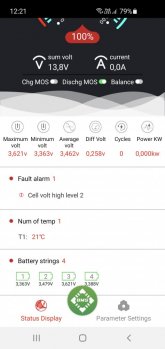I build a 4S, 12V, 272Ah battery bank.
I charged the battery, did a capacity test and charged again.
This is now what the BMS shows:

It has total 0.25V difference between cells after loading.
Is this bad?
When I start discharging, the cells quickly equalize and difference becomes around 0.05V (I think about the measuring fault of the BMS).
Should I a top balance? Or is this fine?
One thing that surprised me: the BMS -daly smart 250A, is not activating the balancing: any idea why this is the case?
Balancing seems only active when charging or discharging...
Walter
I charged the battery, did a capacity test and charged again.
This is now what the BMS shows:

It has total 0.25V difference between cells after loading.
Is this bad?
When I start discharging, the cells quickly equalize and difference becomes around 0.05V (I think about the measuring fault of the BMS).
Should I a top balance? Or is this fine?
One thing that surprised me: the BMS -daly smart 250A, is not activating the balancing: any idea why this is the case?
Balancing seems only active when charging or discharging...
Walter



